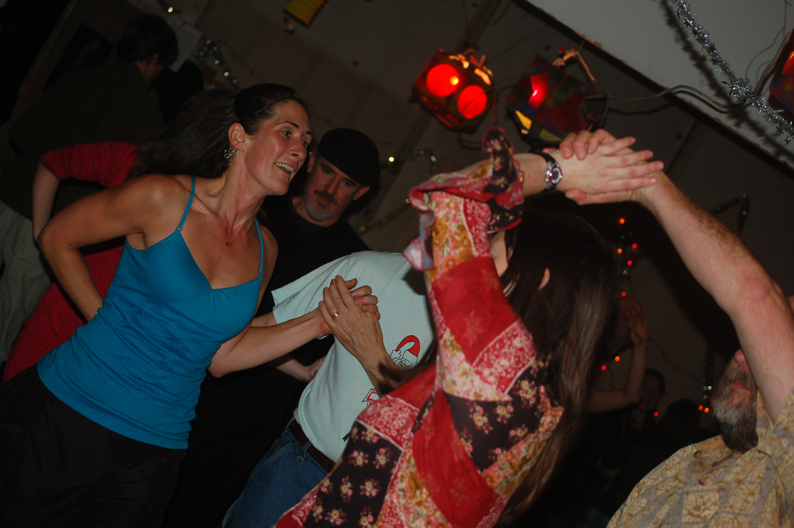On a howling New Year’s Eve night with snow and rain flying sideways, someone driving by Renn Tolman’s boat shop on Kachemak Drive might not know that inside his shop a full-on dance party rumbled. If not for a line of cars parked from Northern Enterprises Boat Yard for almost a half-mile to the west, you might not know anything went on.
For those in the know, which is to say anyone connected to Homer’s vibrant contra and square dance community, Renn’s shop was the place to be on New Year’s Eve, and has been since … well, since dang near forever as Homer memories go, more than 20 years.
Some party lanterns, a few strings of colored Christmas lights and paper decorations added a festive flair to the shop, but a tool bench, boat plans tacked to the wall and rough drywall made it clear this was a working guy’s place. It didn’t matter. The dancers and the dance made the shop beautiful.
Women in swinging skirts and men in fancy shirts lined up facing each other in sets — or, because the gender balance wasn’t exactly equal, ladies facing ladies. Rich Kleinleder, who calls the monthly contra dances, did some instructions, and after a few fumbling tries for newer dancers, most everyone caught on.
An all-ages, family friendly affair, dancers ranged from children barely out of kindergarten to white haired elders. Youth in high school or college added a hipster tone, and it appeared there was a bit of serious flirting among unattached singles.
“It’s a great place to meet people,” said Willy Dunne, a longtime member of the Homer contra and square dance community. “The dances can be flirtatious sometimes. I know more than one couple who met dancing and still come to the dance camps.”
Contra dancing isn’t the dosey-do of square dancing, but a kinetic weaving in and out of dancers. In the dim, red-tinted light, the swirl of dancers looked like an aurora borealis of bodies, arms and feet — in XtraTufs. “Wear clean, soft soled shoes,” is the only rule for footwear. Many just wore socks, and a few were barefoot.
“The beauty of the thing is when everybody does get it, it’s just a smooth flow,” Dunne said. “It’s pretty magical when it clicks and everybody’s dancing to the music at the same beat. It’s a transcendent thing.”
Over in a corner between a piano and a tool bench, Tolman himself played the flute while Troy MacIllivray, visiting from Nova Scotia, played the fiddle. Knute Tonga played guitar. They played traditional jigs and reels, the sort of songs rooted in memory of the Canadian and American Anglo-Celtic immigrants — 4/4 time with a steady beat.
Contra dancing goes back to 17th century English country dances. The term itself is from the French, who created a version they called contredanse. Contra dancing is more rooted in New England and square dancing in the American South and Applachian. In Tolman’s home town of Nelson, N.H., there have been weekly contra dances since the 1940s.
The New Year’s Eve contra dance is the highlight of Homer’s dance season running from September to May. Dances are held monthly on a Saturday at West Homer Elementary School. The next dance is 7:30 p.m. Jan. 19. Admission is $6 at the door, with children 16 and under admitted free.
Homer’s contra and square dances date back to the mid-1980s and became regular in 1989. Sally Kabisch, Tom Kizzia, Tolman and Mary Griswold formed one of the first dance bands, Rather Be Dancing, who played regularly. Dancers committed to monthly dances in 1990. Laura Patty and Rich Kleinleder have been the regular callers, with Dave Stutzer picking up the art. Newer bands include the Spit City Slickers and the Tonga Family Band.
New Year’s Eve contra dances started at the Art Barn on East End Road in the early 1990s. Dunne said he remembered playing bass with his daughter Jenny in a pack on his back. The first New Year’s Eve dance someone forgot to turn up the oil stove and it was 20 below inside.
“We got the Art Barn filled up and dancing and it started warming up,” he said. “We had to keep retuning our instruments because of the temperature change.”
The dances later moved to Tolman’s boat shop, “which has just been a really beautiful tradition,” Dunne said.
The monthly dances include square dancing, considered a bit more difficult for beginners, as well as a waltz or two during the night. Dances are announced on KBBI and in the Homer News and on a new Facebook group page, Dance Homer. It’s a loosely organized operation.
“We create our own music. We create our own dance, and everybody cooperates,” Dunne said. “Instead of being entertained by somebody else, we create our own magic.”
Michael Armstrong can be reached at michael.armstrong@homernews.com.


